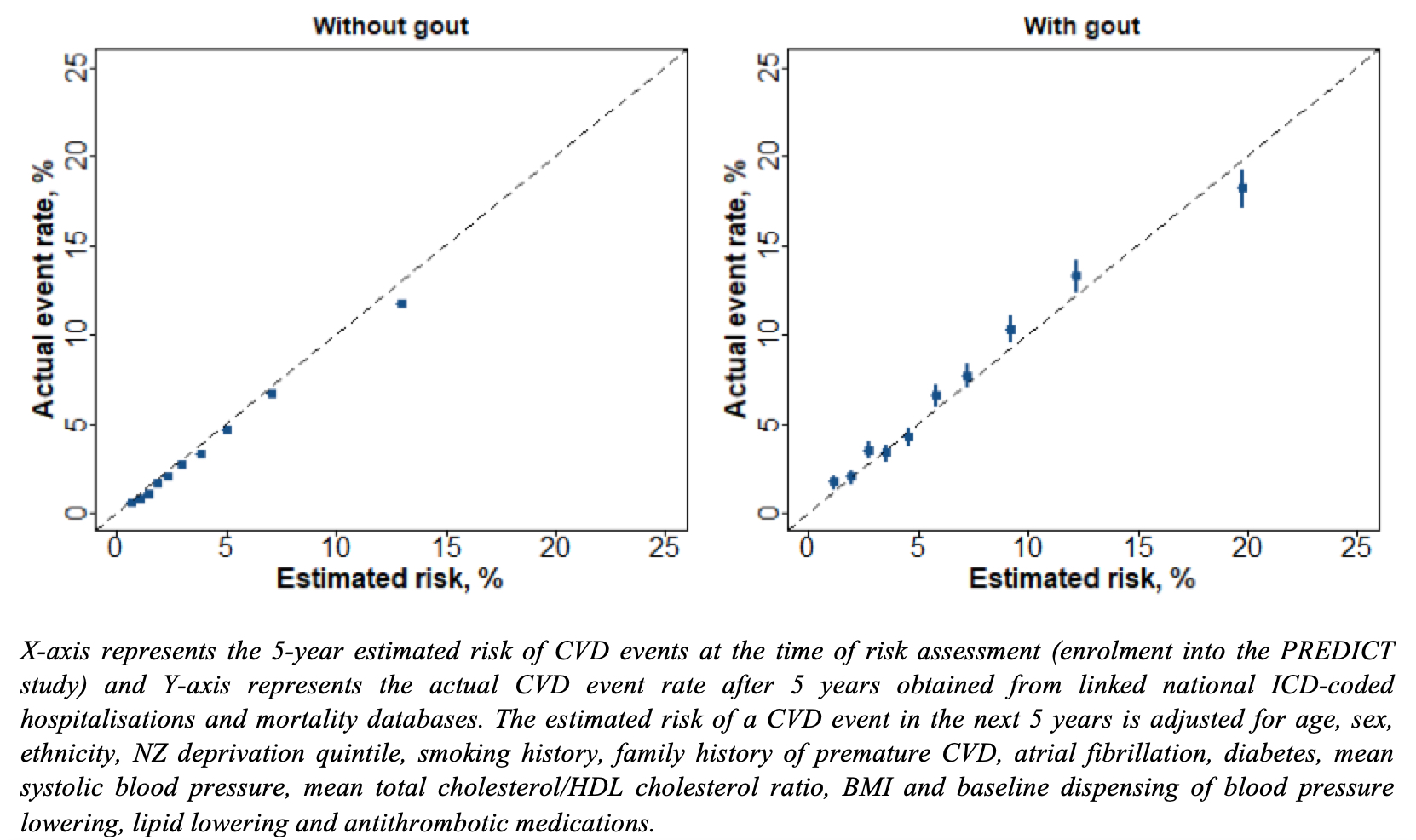Session Information
Session Type: Abstract Session
Session Time: 5:00PM-5:50PM
Background/Purpose: Some studies have reported that gout is an independent risk factor for cardiovascular disease (CVD). Individual-level cardiovascular risk prediction equations have been developed and validated for the New Zealand population using a comprehensive primary care dataset (PREDICT-1°) (Pylypchuk, Lancet 2018). We assessed the performance of these equations in people with gout and recalibrated the primary prevention equation to improve the prediction of CVD events in people with this condition.
Methods: The PREDICT study recruits people in primary care when general practitioners in New Zealand use PREDICT software to routinely assess their patients’ risk profile for CVD, which are prospectively linked to national ICD-coded hospitalisation and mortality databases. The study population included men and women (ages 30-74 years) who had no prior CVD, renal disease or congestive heart failure. A validated national health data definition of gout was used to identify those with gout: discharge diagnosis of gout (ICD-9 274, ICD-10 M10) from a public hospital admission or dispensed gout specific medications (Winnard, Rheumatology 2012). Baseline estimates of 5-year CVD risk (of cardiovascular death, non-fatal myocardial infarction, stroke, or other vascular event) were calculated using sex-specific PREDICT-1° risk scores and initially assessed via the slope between estimated and observed risk on the calibration plot (“slope”). Gout was added as a binary predictor to the recalibrated risk models.
Results: From January 1, 2007 to December 31, 2018, 441,723 people (56% men) had a PREDICT-1° risk assessment (Table). Of these, 23,229 met the definition of gout (3325 females and 19,904 males). In the whole cohort, 14,693 (3.3%) people had a first CVD event within 5 years of risk assessment. Of these, 1505 occurred in people with gout (6.5% event rate) and 13,188 occurred in people without gout (3.2% event rate). The risk scores underestimated the risk of CVD events in people with gout compared with people without gout (slope = 0.88) (Figure). This was more pronounced in women with gout (slope = 0.77) compared with men (slope = 0.96). Adding gout to the recalibrated risk estimates demonstrated that gout was independently associated with an increased risk of CVD events (adj. HR (95% CI) = 1.24 (1.08-1.42) for women; 1.21 (1.14-1.28) for men).
Conclusion: Current cardiovascular risk prediction equations underestimate the risk of CVD in people with gout. Despite adjustment for known CVD risk factors, gout independently increased the hazard ratio for CVD events.
 Table. Participant characteristics (n = 441,723). Data are shown n (%), except age in years.
Table. Participant characteristics (n = 441,723). Data are shown n (%), except age in years.
 Figure. Estimated versus actual CVD event rate in people with and without gout.
Figure. Estimated versus actual CVD event rate in people with and without gout.
To cite this abstract in AMA style:
Cai K, Wu B, Dalbeth N, Jackson R, Poppe K. The Association Between Gout and Cardiovascular Disease Outcomes: Assessment and Recalibration of Individual-level Primary Prevention Risk Prediction Equations in Approximately 450,000 New Zealanders [abstract]. Arthritis Rheumatol. 2020; 72 (suppl 10). https://acrabstracts.org/abstract/the-association-between-gout-and-cardiovascular-disease-outcomes-assessment-and-recalibration-of-individual-level-primary-prevention-risk-prediction-equations-in-approximately-450000-new-zealanders/. Accessed .« Back to ACR Convergence 2020
ACR Meeting Abstracts - https://acrabstracts.org/abstract/the-association-between-gout-and-cardiovascular-disease-outcomes-assessment-and-recalibration-of-individual-level-primary-prevention-risk-prediction-equations-in-approximately-450000-new-zealanders/
